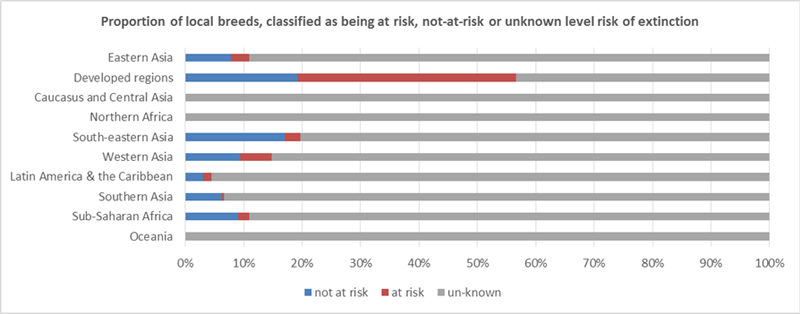Sustainable Development Goal indicators for livestock diversity
The 2030 Agenda for Sustainable Development, including the 17 Sustainable Development Goals (SDGs), was adopted by world leaders in September 2015 and came into force on 1 January 2016.
SDG indicators are key to monitoring the implementation of this global agenda. In March 2016, mandated by the UN General Assembly, the UN Statistical Commission identified a global indicator framework comprising 230 indicators to monitor the 169 SDG targets.
Two of those SDG indicators are directly linked to animal genetic resources and based on data from DAD-IS.
2.5.1 Number of plant and animal genetic resources for food and agriculture secured in either medium or long term conservation facilities
The animal component is calculated as the number of local breeds stored within a genebank collection with an amount of genetic material stored which is required to reconstitute the breed (based on the guidelines on Cryconservation of animal genetic resources, FAO, 2012, accessible at http://www.fao.org/docrep/016/i3017e/i3017e00.htm). The guidelines were endorsed by the Commission on Genetic Resources for Food and Agriculture at its Thirteenth Regular Session (http://www.fao.org/docrep/meeting/024/mc192e.pdf).
2.5.2: Proportion of local breeds, classified as being at risk of extinction
The indicator is based on the most up to date data contained in FAO’s Global Databank for Animal Genetic Resources (DAD-IS) at the time of calculation. Risk classes are defined based on population sizes of breeds reported to DAD-IS. The risk class is considered to be “unknown” if (i) no population sizes are reported or (ii) the most recent population size reported refers to a year more than 10 years before the year of calculation.
Results based on the data available in DAD-IS as of February 2017 are presented in the figure below figure. Across the world, if extinct breeds are excluded, 67 percent of local breeds (i.e. breeds occurring in only one country) are classified as being of unknown status, 20 percent as at risk, and 13 percent as not at risk. Results vary greatly across regions. With the exception of North America and Europe, more than 80 percent of local breeds are of unknown status.
Indicator 2.5.2. of Sustainable Development Goals on the proportion of local breeds, classified as being at risk of risk of extinction (February 2017)


